ExponentHR is a comprehensive human resources management software designed to streamline HR processes and enhance workforce management for businesses of all sizes. With its range of features and functionalities, ExponentHR aims to simplify tasks related to employee management, payroll, benefits administration, time tracking, and more. In this blog we will read about top ExponentHR alternatives.
Table of Contents
ToggleBenefits for Businesses
ExponentHR offers a centralized platform for managing various HR functions, allowing businesses to efficiently handle tasks such as employee onboarding, performance management, and compliance tracking.
The software provides customizable solutions tailored to meet the specific needs of different industries and organizational structures.
With ExponentHR, businesses can automate repetitive HR tasks, reduce manual errors, and improve overall productivity.
The platform also offers self-service options for employees, empowering them to access relevant HR information, update personal details, and request time off with ease.
Potential Drawbacks or Limitations
While ExponentHR offers a robust set of features, some businesses may find the user interface complex or difficult to navigate, especially for employees who are not tech-savvy.
Depending on the size and complexity of the organization, the pricing plans for ExponentHR may be relatively high, making it less accessible for small businesses with limited budgets.
Like any software solution, ExponentHR may encounter occasional technical issues or downtime, which can disrupt HR operations and impact business continuity.
Overall, ExponentHR serves as a valuable tool for businesses looking to streamline their HR processes and improve workforce management efficiency. However, it’s essential for organizations to carefully evaluate their specific needs and consider any potential drawbacks before committing to the software.
Why Consider Alternatives to ExponentHR
Businesses may consider exploring alternatives to ExponentHR for several reasons, each stemming from specific challenges or limitations they encounter with the platform. Understanding these factors is crucial for businesses aiming to optimize their HR processes and find a solution that best fits their needs.
Limited Customization Options
ExponentHR, while offering a range of features, may lack the flexibility needed to accommodate the unique requirements of certain industries or organizational structures. Businesses with complex HR needs may find themselves constrained by the platform’s limited customization options, leading to inefficiencies and gaps in functionality.
Scalability Concerns
As businesses grow and evolve, their HR requirements often change in tandem. Some users may find that ExponentHR does not scale seamlessly with their organization’s growth, resulting in scalability concerns and potential limitations in accommodating an expanding workforce or evolving HR processes.
User Experience Issues
The user interface and overall user experience of ExponentHR may not resonate well with all employees, particularly those accustomed to more intuitive and user-friendly software solutions. Difficulties in navigation or usability issues can hinder employee adoption and impact overall productivity.
Cost Considerations:
While ExponentHR offers valuable features, the cost of the platform may be prohibitive for some businesses, especially smaller organizations with tighter budgets. The pricing structure and associated fees may not align with the perceived value or return on investment for certain users, prompting them to seek more cost-effective alternatives.
Lack of Integration Capabilities
Integration with other essential business systems and applications is vital for maximizing efficiency and data accuracy within the HR ecosystem. Businesses reliant on disparate software solutions may find ExponentHR’s integration capabilities lacking, leading to data silos, manual data entry, and inefficiencies in HR operations.
Also Read: E-Learning Statistics 2024
Emphasizing the Importance of Finding the Right HR Solution
Selecting the right HR software solution is paramount for businesses aiming to streamline their HR processes, enhance employee engagement, and drive organizational success. While ExponentHR may be suitable for some users, exploring alternative options allows businesses to evaluate a diverse range of features, functionalities, and pricing models to find a solution that aligns closely with their specific needs and objectives. By conducting thorough research, seeking input from stakeholders, and leveraging free trials or demos, businesses can make informed decisions and invest in an HR solution that serves as a strategic asset in achieving their HR goals.
Factors to Consider When Choosing HR Software
When evaluating HR software alternatives, businesses should consider several key factors to ensure they select a solution that best meets their needs and aligns with their organizational goals. By carefully assessing these criteria, businesses can make informed decisions and invest in a software solution that enhances HR efficiency, drives employee engagement, and supports overall business success.
Scalability
Consider the scalability of the HR software solution to accommodate your organization’s growth over time. Ensure that the software can scale seamlessly with your expanding workforce and evolving HR requirements without compromising performance or functionality.
Customization
Look for HR software that offers robust customization options to tailor the platform to your organization’s unique needs and workflows. The ability to customize forms, fields, workflows, and reports allows businesses to adapt the software to their specific processes and preferences.
Ease of Use
User-friendly software is essential for ensuring high adoption rates and maximizing employee engagement. Choose HR software with an intuitive interface, simple navigation, and clear instructions to minimize training time and support smooth user interactions.
Pricing
Evaluate the pricing structure and associated costs of the HR software to ensure it fits within your budgetary constraints. Consider factors such as subscription fees, implementation costs, add-on modules, and ongoing maintenance expenses to determine the total cost of ownership over time.
Integrations
Assess the integration capabilities of the HR software to ensure seamless connectivity with other essential business systems and applications. Look for software that offers pre-built integrations with popular platforms such as payroll, benefits administration, time tracking, and applicant tracking systems.
Compliance and Security
Prioritize HR software that prioritizes compliance with industry regulations and data security standards. Ensure that the software offers robust data encryption, role-based access controls, and audit trails to safeguard sensitive HR information and protect against data breaches.
Analytics and Reporting
Look for HR software that provides robust analytics and reporting capabilities to gain insights into workforce trends, performance metrics, and HR KPIs. Advanced reporting tools enable data-driven decision-making and facilitate strategic HR planning and analysis.
Customer Support
Consider the level of customer support offered by the HR software vendor, including access to technical support, training resources, and account management services. Choose a vendor with a reputation for responsive support and proactive assistance to ensure a positive user experience and timely resolution of any issues or challenges.
By carefully evaluating these factors and prioritizing the features and functionalities that matter most to your organization, you can select an HR software solution that optimizes HR processes, enhances employee satisfaction, and drives business growth.
Also Read: 10 Best AI Tools For Human Resources 2024
Factors to Consider When Choosing HR Software
When evaluating HR software alternatives, businesses should consider several key factors to ensure they select a solution that best meets their needs and aligns with their organizational goals. By carefully assessing these criteria, businesses can make informed decisions and invest in a software solution that enhances HR efficiency, drives employee engagement, and supports overall business success.
Scalability
Consider the scalability of the HR software solution to accommodate your organization’s growth over time. Ensure that the software can scale seamlessly with your expanding workforce and evolving HR requirements without compromising performance or functionality.
Customization
Look for HR software that offers robust customization options to tailor the platform to your organization’s unique needs and workflows. The ability to customize forms, fields, workflows, and reports allows businesses to adapt the software to their specific processes and preferences.
Ease of Use
User-friendly software is essential for ensuring high adoption rates and maximizing employee engagement. Choose HR software with an intuitive interface, simple navigation, and clear instructions to minimize training time and support smooth user interactions.
Pricing
Evaluate the pricing structure and associated costs of the HR software to ensure it fits within your budgetary constraints. Consider factors such as subscription fees, implementation costs, add-on modules, and ongoing maintenance expenses to determine the total cost of ownership over time.
Integrations
Assess the integration capabilities of the HR software to ensure seamless connectivity with other essential business systems and applications. Look for software that offers pre-built integrations with popular platforms such as payroll, benefits administration, time tracking, and applicant tracking systems.
Compliance and Security
Prioritize HR software that prioritizes compliance with industry regulations and data security standards. Ensure that the software offers robust data encryption, role-based access controls, and audit trails to safeguard sensitive HR information and protect against data breaches.
Analytics and Reporting
Look for HR software that provides robust analytics and reporting capabilities to gain insights into workforce trends, performance metrics, and HR KPIs. Advanced reporting tools enable data-driven decision-making and facilitate strategic HR planning and analysis.
Customer Support
Consider the level of customer support offered by the HR software vendor, including access to technical support, training resources, and account management services. Choose a vendor with a reputation for responsive support and proactive assistance to ensure a positive user experience and timely resolution of any issues or challenges.
By carefully evaluating these factors and prioritizing the features and functionalities that matter most to your organization, you can select an HR software solution that optimizes HR processes, enhances employee satisfaction, and drives business growth.
Also Read: 10 Best Web Scraping Tools: Which Should You Use?
List of Top ExponentHR Alternatives
1.BambooHR
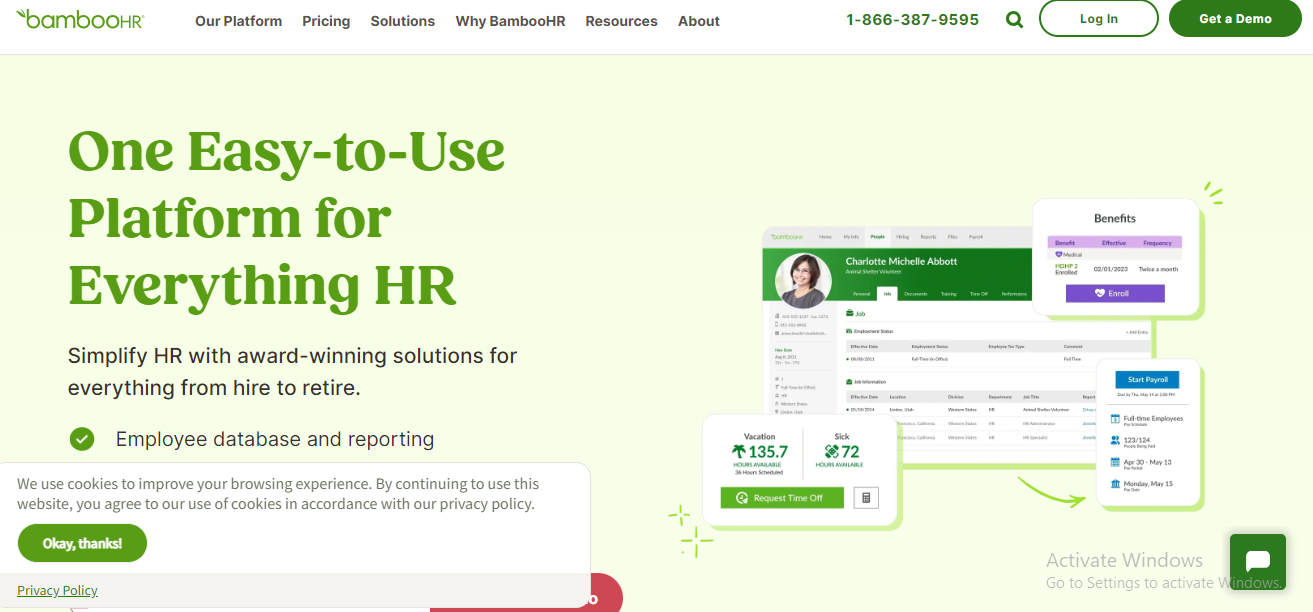
BambooHR is a popular HR software solution known for its user-friendly interface and comprehensive HR management capabilities. Key features include employee record management, time tracking, performance management, applicant tracking, and reporting. Pros include intuitive interface, customizable workflows, and excellent customer support. Cons include limited customization options for some features and pricing structure based on employee count.
Benefits of BambooHR
- User-Friendly Interface: BambooHR offers an intuitive and easy-to-navigate interface, making it simple for users to access and utilize its features.
- Comprehensive HR Management: It provides a wide range of HR management capabilities, including employee record management, time tracking, performance management, applicant tracking, and reporting, allowing businesses to streamline their HR processes.
- Customizable Workflows: BambooHR allows customization of workflows to match the specific needs and processes of your organization, enhancing efficiency and productivity.
- Excellent Customer Support: Users praise BambooHR for its responsive and helpful customer support team, providing assistance whenever needed.
- Pricing: BambooHR’s pricing structure is based on the number of employees in your organization, with tiered pricing plans to accommodate businesses of different sizes.
Pros
- Intuitive interface for easy navigation.
- Comprehensive HR management capabilities.
- Customizable workflows to suit specific organizational needs.
- Responsive and helpful customer support.
Cons
- Limited customization options for certain features may not meet the needs of all businesses.
- Pricing structure based on employee count may not be ideal for organizations with fluctuating staffing levels.
2. Gusto
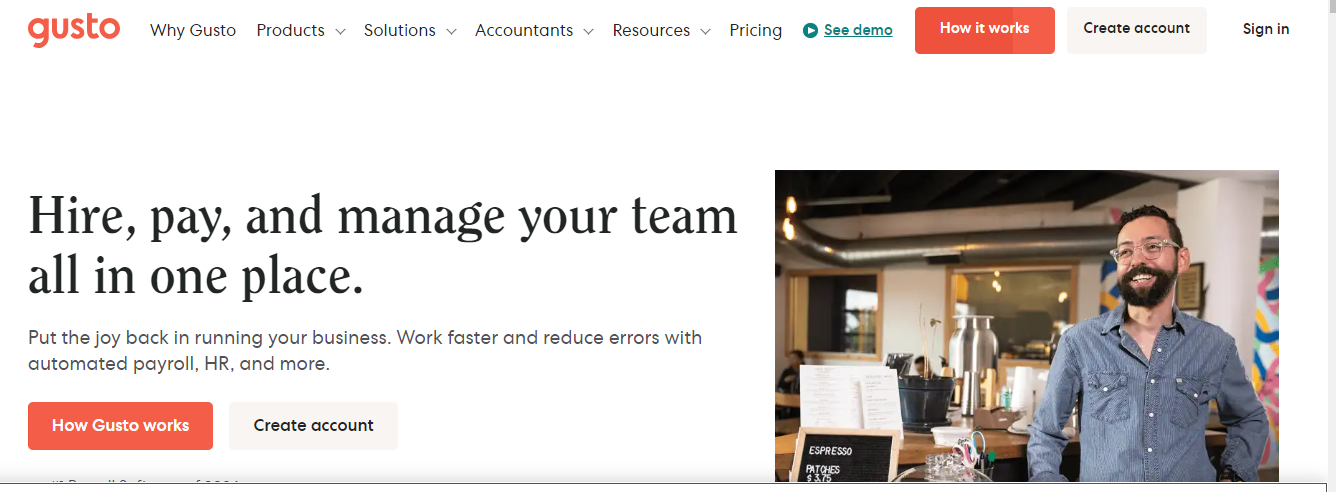
Gusto offers a cloud-based HR, payroll, and benefits platform designed for small and medium-sized businesses. Its features include payroll processing, benefits administration, time tracking, and employee onboarding. Pros include easy-to-use interface, automated payroll tax filing, and integrated HR and benefits management. Cons include limited scalability for larger organizations and occasional software glitches.
Benefits of Gusto
- Cloud-Based HR, Payroll, and Benefits Platform: Gusto provides a comprehensive cloud-based solution for HR, payroll, and benefits management, catering specifically to the needs of small and medium-sized businesses.
- Easy-to-Use Interface: Gusto offers an intuitive and user-friendly interface, making it easy for users to navigate and utilize its features without extensive training.
- Automated Payroll Tax Filing: Gusto automates payroll tax filing, helping businesses stay compliant with tax regulations and reducing the risk of errors.
- Integrated HR and Benefits Management: Gusto integrates HR and benefits management, allowing businesses to centralize employee data and streamline administrative tasks such as onboarding and benefits enrollment.
- Pricing: Gusto’s pricing is based on a per-employee, per-month basis, with additional costs for certain features such as advanced HR tools and employee benefits administration.
Pros
- Comprehensive cloud-based solution for HR, payroll, and benefits management.
- User-friendly interface for easy navigation and usage.
- Automated payroll tax filing for compliance.
- Integration of HR and benefits management for streamlined processes.
Cons
- Limited scalability for larger organizations may not meet the needs of growing businesses.
- Occasional software glitches may disrupt operations and require troubleshooting.
3. Paycor
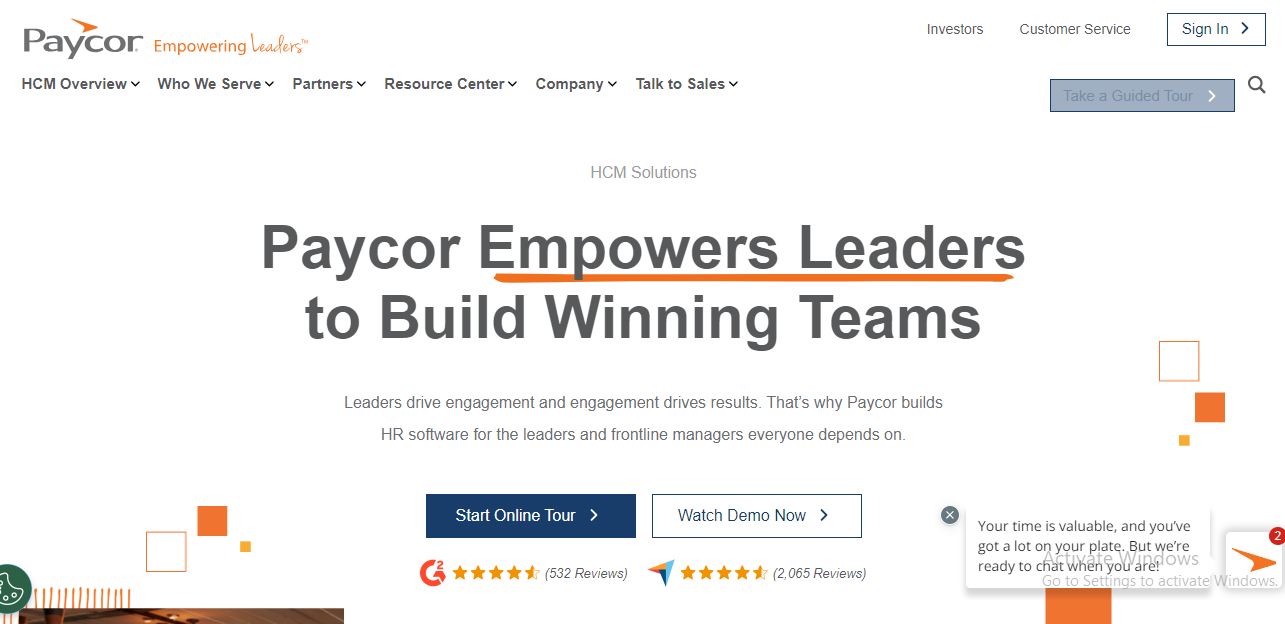
Paycor provides a comprehensive HR and payroll software solution for businesses of all sizes. Its features include payroll processing, time and attendance tracking, benefits administration, and HR analytics. Pros include customizable reporting options, integrated HR and payroll functionality, and dedicated customer support. Cons include occasional system downtime and complexity for first-time users.
Benefits of Paycor
- Comprehensive HR and Payroll Solution: Paycor offers a complete suite of HR and payroll software, covering payroll processing, time and attendance tracking, benefits administration, and HR analytics, catering to the needs of businesses of all sizes.
- Customizable Reporting Options: Paycor provides customizable reporting options, allowing users to generate reports tailored to their specific business requirements, enabling better insights and decision-making.
- Integrated HR and Payroll Functionality: With integrated HR and payroll functionality, Paycor streamlines processes and reduces administrative burden by centralizing employee data and payroll information.
- Dedicated Customer Support: Paycor offers dedicated customer support to assist users with any questions or issues they may encounter, ensuring a smooth experience.
- Pricing: Paycor’s pricing is typically customized based on the specific needs and size of each organization, with various pricing plans available.
Pros
- Comprehensive suite of HR and payroll solutions.
- Customizable reporting options for better insights.
- Integration of HR and payroll functionality.
- Dedicated customer support for assistance.
Cons
- Occasional system downtime may disrupt operations.
- Complexity for first-time users may require additional training or support to fully utilize the platform.
4.ADP Workforce Now

ADP Workforce Now is an all-in-one HR and payroll platform designed for midsize and large enterprises. It offers features such as payroll processing, talent management, benefits administration, and workforce analytics. Pros include robust compliance capabilities, extensive integrations, and scalable solutions. Cons include high pricing for smaller businesses and complex implementation processes.
Benefits of ADP Workforce Now
- All-in-One HR and Payroll Platform: ADP Workforce Now provides a comprehensive suite of HR and payroll solutions, including payroll processing, talent management, benefits administration, and workforce analytics, catering specifically to midsize and large enterprises.
- Robust Compliance Capabilities: ADP Workforce Now offers robust compliance capabilities, helping businesses stay compliant with changing regulations and reducing the risk of penalties.
- Extensive Integrations: ADP Workforce Now integrates with a wide range of third-party systems and applications, allowing businesses to connect their HR and payroll data with other software tools for increased efficiency and productivity.
- Scalable Solutions: ADP Workforce Now offers scalable solutions that can grow with your business, accommodating the needs of midsize and large enterprises.
- Pricing: ADP Workforce Now’s pricing is typically customized based on the specific needs and size of each organization, with costs varying depending on the selected features and services.
Pros
- Comprehensive suite of HR and payroll solutions.
- Robust compliance capabilities for regulatory adherence.
- Extensive integrations with third-party systems and applications.
- Scalable solutions suitable for midsize and large enterprises.
Cons
- High pricing may be prohibitive for smaller businesses with limited budgets.
- Complex implementation processes may require extensive time and resources for deployment and setup.
5. Zenefits(Trinet)
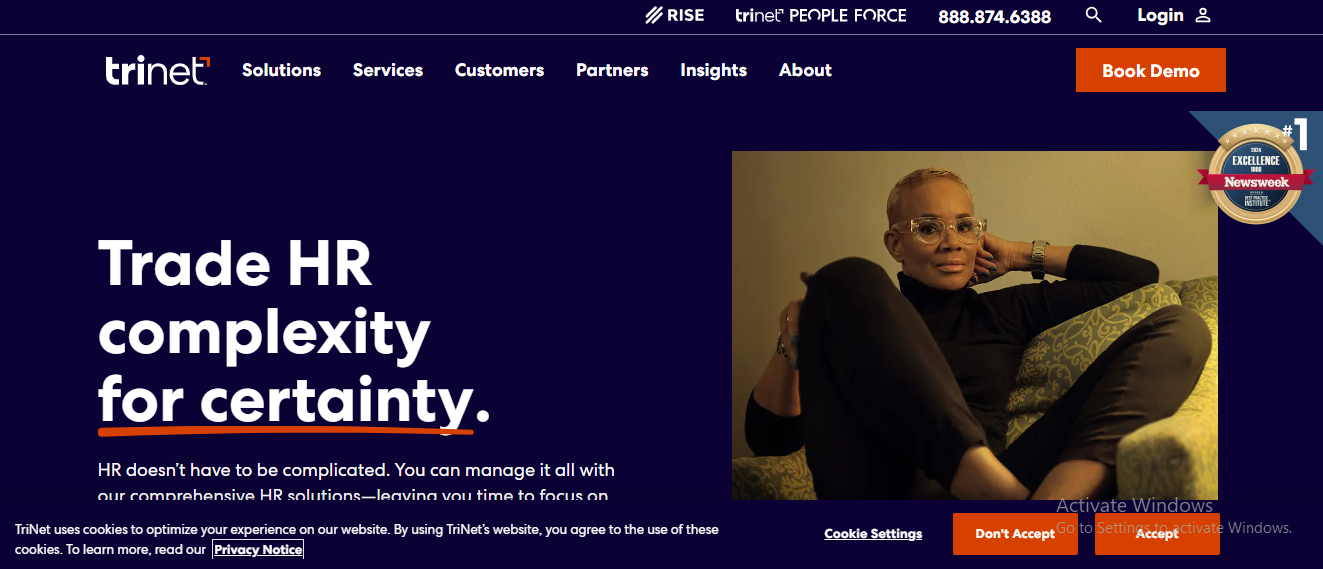
Zenefits is a cloud-based HR platform that offers HR, payroll, benefits, and compliance solutions for small and medium-sized businesses. Its features include employee onboarding, time tracking, benefits administration, and performance management. Pros include easy setup and integration, automated compliance features, and a user-friendly interface. Cons include occasional customer service issues and limited customization options.
Benefits of Zenefits
- Comprehensive Cloud-Based HR Platform: Zenefits offers a comprehensive suite of HR solutions, including HR, payroll, benefits, and compliance, specifically designed for small and medium-sized businesses.
- Easy Setup and Integration: Zenefits provides easy setup and integration with existing systems, allowing businesses to quickly onboard and start using the platform without significant downtime or disruption.
- Automated Compliance Features: Zenefits includes automated compliance features, helping businesses stay compliant with regulations and reduce the risk of penalties by automating tasks such as tax filings and reporting.
- User-Friendly Interface: Zenefits offers a user-friendly interface that makes it easy for users to navigate and utilize its features without extensive training or technical expertise.
- Pricing: Zenefits’ pricing is typically based on a per-employee, per-month basis, with additional costs for certain features such as advanced HR tools and benefits administration.
Pros
- Comprehensive suite of HR solutions for small and medium-sized businesses.
- Easy setup and integration with existing systems.
- Automated compliance features for regulatory adherence.
- User-friendly interface for easy navigation and usage.
Cons
- Occasional customer service issues may impact support quality.
- Limited customization options for tailoring the platform to specific business needs.
6. Namely
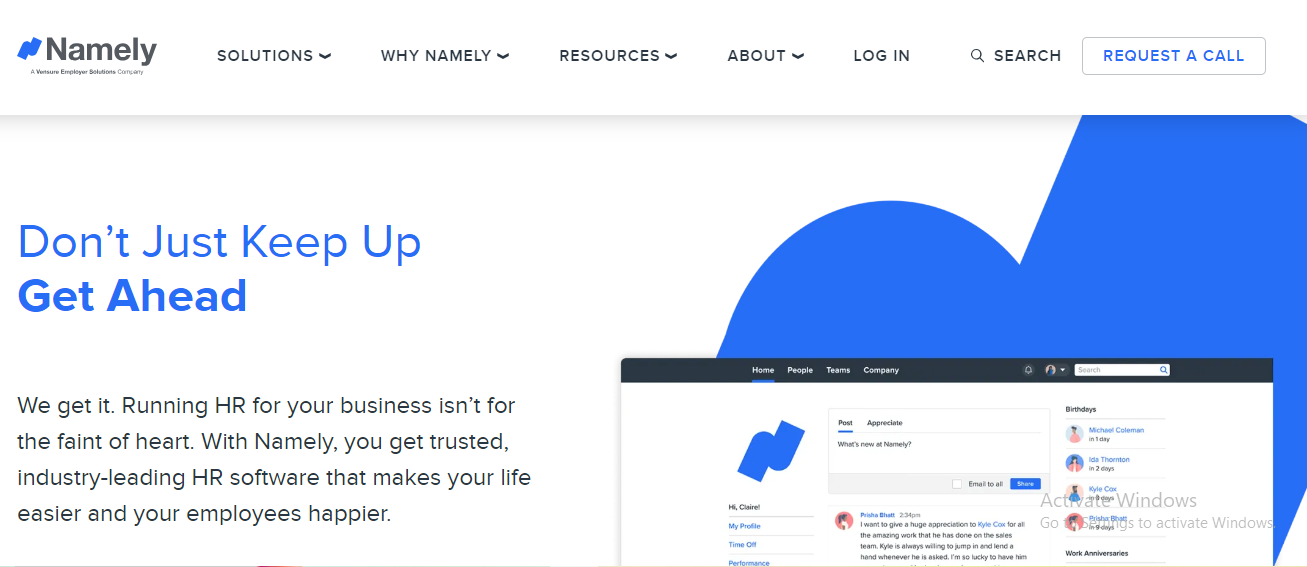
Namely is a comprehensive HR platform that combines HR, payroll, benefits, and talent management functionalities in one integrated solution. Its features include HRIS, payroll processing, time tracking, performance management, and employee engagement tools. Pros include robust reporting capabilities, personalized support, and employee self-service options. Cons include occasional software bugs and pricing based on employee count.
Benefits of Namely
- Comprehensive HR Platform: Namely offers a comprehensive suite of HR solutions, including HR, payroll, benefits, talent management, and employee engagement tools, all integrated into one platform for seamless management.
- Robust Reporting Capabilities: Namely provides robust reporting capabilities, allowing businesses to generate customizable reports to gain insights into their workforce and make data-driven decisions.
- Personalized Support: Namely offers personalized support to assist users with implementation, training, and ongoing usage, ensuring a smooth experience and addressing any issues promptly.
- Employee Self-Service Options: Namely includes employee self-service options, empowering employees to access and manage their HR information, such as updating personal details and viewing pay stubs, reducing administrative burden.
- Pricing: Namely’s pricing is typically based on a per-employee, per-month basis, with additional costs for certain features and services, such as implementation and support.
Pros
- Comprehensive suite of HR solutions for streamlined management.
- Robust reporting capabilities for data-driven insights.
- Personalized support for implementation and ongoing usage.
- Employee self-service options for increased efficiency.
Cons
- Occasional software bugs may impact user experience and require troubleshooting.
- Pricing based on employee count may not be suitable for organizations with fluctuating staffing levels or smaller budgets.
7. Paychex Flex
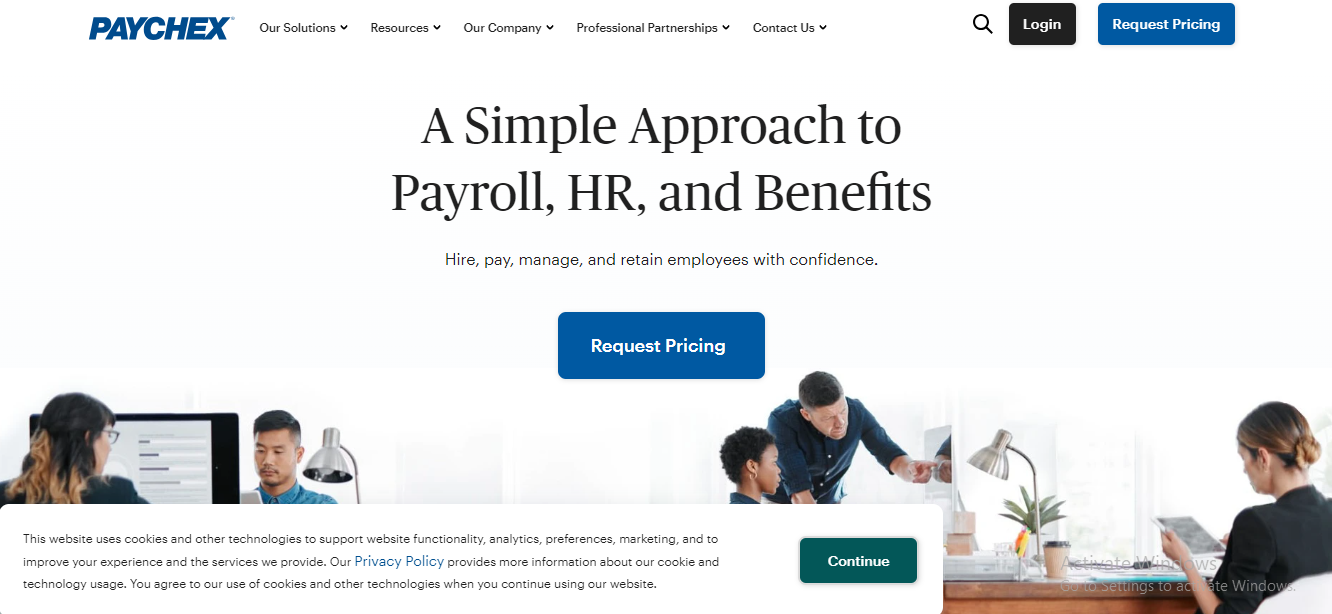
Paychex Flex is a cloud-based HR and payroll solution designed for businesses of all sizes. It offers features such as payroll processing, benefits administration, time and attendance tracking, and HR compliance. Pros include flexible pricing options, mobile accessibility, and customizable reporting. Cons include occasional customer service delays and limited scalability for larger enterprises.
Benefits of Paychex Flex
- Comprehensive HR and Payroll Solution: Paychex Flex offers a comprehensive suite of HR and payroll solutions, including payroll processing, benefits administration, time and attendance tracking, and HR compliance, catering to businesses of all sizes.
- Flexible Pricing Options: Paychex Flex provides flexible pricing options, allowing businesses to choose the package that best suits their needs and budget, with scalable solutions to accommodate growth.
- Mobile Accessibility: Paychex Flex offers mobile accessibility, enabling users to access and manage HR and payroll tasks on-the-go, increasing flexibility and convenience.
- Customizable Reporting: Paychex Flex includes customizable reporting capabilities, allowing businesses to generate reports tailored to their specific requirements, providing insights for better decision-making.
- Pricing: Paychex Flex’s pricing is typically customized based on the specific needs and size of each organization, with various pricing plans available.
Pros
- Comprehensive suite of HR and payroll solutions for businesses of all sizes.
- Flexible pricing options to accommodate different budgets and needs.
- Mobile accessibility for convenient access to HR and payroll tasks.
- Customizable reporting for tailored insights.
Cons
- Occasional customer service delays may impact support response times.
- Limited scalability for larger enterprises may not meet the needs of growing businesses with complex requirements.
8. Rippling
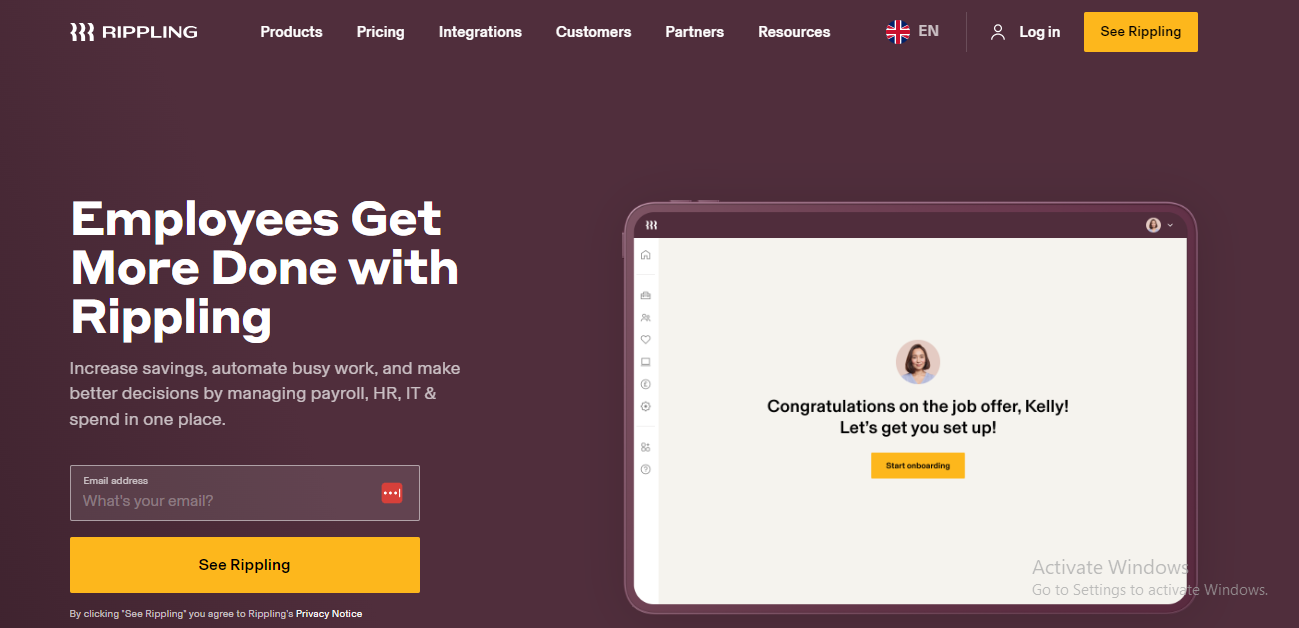
Rippling is an all-in-one HR and IT platform that offers HR, payroll, benefits, and IT management solutions for businesses. Its features include employee onboarding, payroll processing, device management, and security compliance. Pros include seamless integration with existing systems, automated workflows, and customizable employee profiles. Cons include higher pricing compared to some alternatives and limited customization options for certain features.
Benefits of Rippling
- All-in-One HR and IT Platform: Rippling offers a comprehensive suite of HR and IT management solutions, including HR, payroll, benefits, device management, and security compliance, providing businesses with a centralized platform for streamlined management.
- Seamless Integration: Rippling provides seamless integration with existing systems and applications, allowing businesses to connect their HR and IT data for increased efficiency and productivity.
- Automated Workflows: Rippling offers automated workflows for tasks such as employee onboarding and offboarding, payroll processing, and IT provisioning, reducing manual work and improving process efficiency.
- Customizable Employee Profiles: Rippling allows businesses to create customizable employee profiles, enabling them to tailor settings, permissions, and access levels to match individual roles and responsibilities.
- Pricing: Rippling’s pricing is typically based on a per-employee, per-month basis, with additional costs for certain features and services, such as advanced IT management tools and security compliance.
Pros
- Comprehensive suite of HR and IT management solutions for streamlined management.
- Seamless integration with existing systems and applications.
- Automated workflows for increased process efficiency.
- Customizable employee profiles for tailored settings and permissions.
Cons
- Higher pricing compared to some alternatives may be prohibitive for smaller businesses with limited budgets.
- Limited customization options for certain features may not meet the specific needs of all businesses.
9. Kronos Workforce Ready
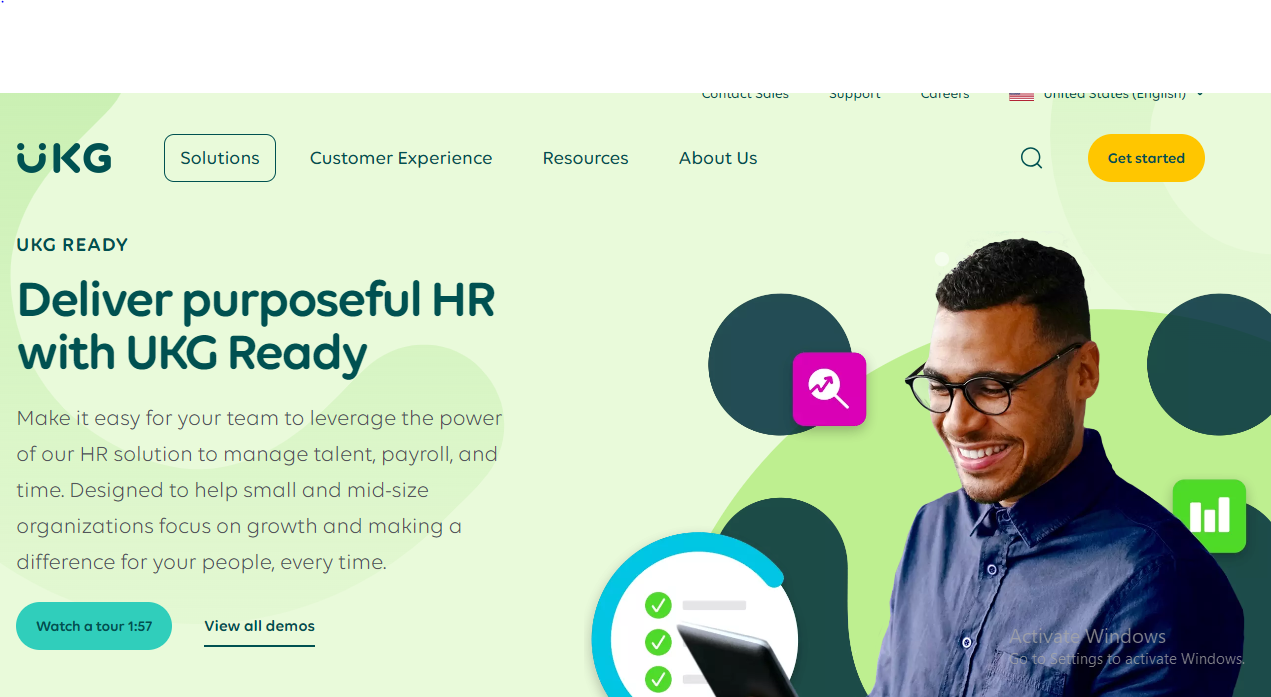
Kronos Workforce Ready is a cloud-based HR and workforce management solution designed for businesses of all sizes. It offers features such as time and attendance tracking, scheduling, payroll processing, and HR analytics. Pros include robust workforce management capabilities, compliance tools, and scalable solutions. Cons include complexity for first-time users and occasional system downtime.
Benefits of Kronos Workforce Ready
- Robust Workforce Management: Kronos Workforce Ready offers robust workforce management capabilities, including time and attendance tracking, scheduling, payroll processing, and HR analytics, providing businesses with comprehensive tools to manage their workforce effectively.
- Compliance Tools: Kronos Workforce Ready includes compliance tools to help businesses stay compliant with labor laws, regulations, and industry standards, reducing the risk of penalties and legal issues.
- Scalable Solutions: Kronos Workforce Ready offers scalable solutions that can grow with your business, accommodating the needs of businesses of all sizes, from small businesses to large enterprises.
- Cloud-Based Platform: Being a cloud-based platform, Kronos Workforce Ready offers accessibility and flexibility, allowing users to access the system from anywhere with an internet connection.
- Pricing: Kronos Workforce Ready’s pricing is typically customized based on the specific needs and size of each organization, with costs varying depending on the selected features, number of employees, and implementation requirements.
Pros
- Comprehensive workforce management capabilities for effective management.
- Compliance tools for staying compliant with labor laws and regulations.
- Scalable solutions suitable for businesses of all sizes.
- Cloud-based platform for accessibility and flexibility.
Cons
- Complexity for first-time users may require additional training or support.
- Occasional system downtime may disrupt operations and impact productivity.
10. Workday HRIS

Workday HRIS is a leading cloud-based HR management platform known for its comprehensive suite of HR and talent management solutions. Its features include HRIS, payroll, benefits administration, talent acquisition, and performance management. Pros include intuitive interface, real-time analytics, and continuous updates. Cons include high pricing for smaller businesses and complex implementation processes.
Benefits of Workday HRIS
- Comprehensive HR Management Platform: Workday HRIS offers a comprehensive suite of HR and talent management solutions, including HRIS, payroll, benefits administration, talent acquisition, and performance management, providing businesses with all the tools they need for effective HR management.
- Intuitive Interface: Workday HRIS features an intuitive and user-friendly interface, making it easy for users to navigate and utilize its features without extensive training or technical expertise.
- Real-Time Analytics: Workday HRIS provides real-time analytics and reporting capabilities, allowing businesses to access up-to-date insights into their workforce and make data-driven decisions.
- Continuous Updates: Workday HRIS offers continuous updates and improvements, ensuring that businesses always have access to the latest features and enhancements to improve their HR processes.
- Pricing: Workday HRIS’s pricing is typically customized based on the specific needs and size of each organization, with costs varying depending on the selected features, number of employees, and implementation requirements.
Pros
- Comprehensive suite of HR and talent management solutions for effective HR management.
- Intuitive interface for easy navigation and usage.
- Real-time analytics and reporting capabilities for data-driven insights.
- Continuous updates to ensure access to the latest features and enhancements.
Cons
- High pricing may be prohibitive for smaller businesses with limited budgets.
- Complex implementation processes may require extensive time and resources for deployment and setup.
Each of these ExponentHR alternatives offers unique features and functionalities to meet the diverse needs of businesses. By carefully evaluating their capabilities, pricing, and customer support, organizations can choose the HR software solution that best aligns with their requirements and goals.
Comparison of ExponentHR Alternatives
| Feature | BambooHR | Gusto | Paycor | ADP Workforce Now | Zenefits | Namely | Paychex Flex | Rippling | Kronos Workforce Ready | Workday HRIS |
|---|---|---|---|---|---|---|---|---|---|---|
| Payroll Processing | ✓ | ✓ | ✓ | ✓ | ✓ | ✓ | ✓ | ✓ | ✓ | ✓ |
| Benefits Management | ✓ | ✓ | ✓ | ✓ | ✓ | ✓ | ✓ | ✓ | ✓ | ✓ |
| Time Tracking | ✓ | ✓ | ✓ | ✓ | ✓ | ✓ | ✓ | ✓ | ✓ | ✓ |
| Employee Onboarding | ✓ | ✓ | ✓ | ✓ | ✓ | ✓ | ✓ | ✓ | ✓ | ✓ |
| HR Analytics | ✓ | ✓ | ✓ | ✓ | ✓ | ✓ | ✓ | ✓ | ✓ | ✓ |
| Talent Management | ✓ | ✓ | ✓ | ✓ | ✓ | ✓ | ✓ | ✓ | ✓ | ✓ |
| Compliance | ✓ | ✓ | ✓ | ✓ | ✓ | ✓ | ✓ | ✓ | ✓ | ✓ |
| Pricing | Moderate | Moderate | Moderate | High | Moderate | High | Moderate | High | Moderate | High |
| Ease of Use | Excellent | Excellent | Moderate | Moderate | Easy | Easy | Easy | Moderate | Moderate | Excellent |
| Customer Support | Good | Good | Excellent | Excellent | Good | Good | Good | Excellent | Good | Excellent |
| Scalability | Good | Moderate | Excellent | Excellent | Good | Moderate | Good | Excellent | Excellent | Excellent |
| Integrations | Good | Good | Excellent | Excellent | Good | Good | Good | Excellent | Excellent | Excellent |
Comparison of ExponentHR Alternatives
This comparison table provides an overview of the key features and functionalities of each ExponentHR alternative. While all solutions offer payroll processing, benefits management, time tracking, and other HR functionalities, they differ in terms of pricing, ease of use, customer support, scalability, and integrations. By evaluating these factors, businesses can choose the alternative that best meets their specific requirements and budget.
Conclusion
In this blog, we explored alternatives to ExponentHR and discussed key factors to consider when evaluating HR software solutions. We highlighted the features, pros, and cons of popular alternatives such as BambooHR, Gusto, Paycor, and others.
It’s crucial for businesses to assess their unique requirements and carefully evaluate multiple alternatives before making a decision. Factors such as pricing, ease of use, customer support, scalability, and integrations play a significant role in determining the best fit for an organization.
By considering these factors and comparing different options, businesses can select the right HR software solution that aligns with their needs and objectives. Taking the time to research and explore alternatives will ultimately lead to long-term success and improved efficiency in managing HR processes.
We encourage readers to explore the listed alternatives in detail, conduct demos or trials, and make informed decisions based on their specific business needs. Finding the right HR software solution can have a significant impact on organizational productivity, employee satisfaction, and overall success.
Interesting Reads:
Top TablePress Alternatives For Creating Table In WordPress Website








